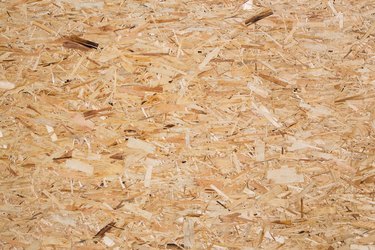
Subfloors are generally made from plywood, oriented strandboard or concrete. Cleaning subfloors is part of the process when you are replacing carpeting or other types of flooring. If a subfloor is not cleaned, deodorized and dried before laying down the new material, you can run into serious problems later.
What to Know About Cleaning Subfloors
Video of the Day
One of the most common kinds of odors in subfloors is pet urine, and an enzymatic pet cleaner will work well for such a cleanup task. These products have enzymes that convert organic waste into carbon dioxide and water. They can also remove grease, oil, blood, wine and food stains. Before applying any cleaners, though, be sure to sweep and vacuum your subfloor completely, including the corners.
Video of the Day
Choose an enzymatic cleaner that is designed for these particular kinds of stains and odors in your subfloor, keeping in mind that you may need to apply the product more than once. If you are dealing with urine, blood or wine stains, choose one that contains protease. Lipase works well on grease and oil, and amylase is better for starch-based stains, sugar, some kinds of sauces and egg stains. Be sure to read the product label for cleaning instructions. It may need to sit on the floor for 24 hours before rinsing and drying.
Other Ways to Clean Subfloors
If you prefer not to use an enzymatic cleaner, you can try a homemade cleaning solution. Combine 1 cup of warm water, 1/4 cup of mild dishwashing soap and 1/3 cup of white vinegar in a spray bottle. Shake well, spray it onto one spot of the subfloor, wipe it off with a cloth and check the results. If it worked, you can then mix a larger amount in a bucket and clean the subfloor with a sponge.
Another method is to combine one part bleach or hydrogen peroxide with three parts warm water and use this to clean your subfloor. Go over it afterward with a mop and clean water and dry it off with towels. Give it another day to dry completely. When using any of these cleaners, be sure to wear protective goggles, a mask and gloves. These solutions are strong and can produce fumes.
Removing Odors From Concrete
Since concrete is porous, it absorbs liquids and can really start to smell, whether it be a subfloor or an indoor or outdoor floor in a kitchen, basement, patio or garage. Enzymatic cleaners also work to neutralize odors on concrete, and it is recommended to choose ones that contain trisodium phosphate for this job.
Mix this product at a ratio of 1/2 cup to 1 gallon of very hot water and once you pour the cleaning solution onto the floor, allow it to soak in for about 10 minutes. Then, use something like a short-bristled nylon deck brush to scrub it in. You will then need to rinse it with hot water two or more times. To clean up the excess water on your subfloors, you may need to vacuum it up with a wet vac. If you don't have one, it is not expensive to rent them.